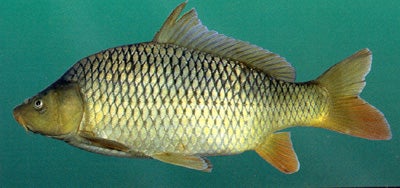SCIENTIFIC NAME:
Cyprinus carpio
CHARACTERISTICS:
Unlike the similar goldfish, the common carp has two barbels on each side of the mouth and a long dorsal fin. The pharyngeal arch contains three rows of teeth. Like the goldfish, however, this species has saw-toothed spines preceding the dorsal and anal fins. The lateral line usually has 35 to 40 scales, and colors range from light olive on the back to yellow on the venter. The caudal fin is often a subdued red to reddish orange. Although the common carp is frequently confused with some species of suckers, such as buffalo (Ictiobus) and carpsuckers (Carpiodes), its barbels and saw-toothed spines easily distinguish it from the others.
ADULT SIZE:
12 to 26 in (305 to 660 mm). Large individuals approach 40 lb (18kg).
STATE RECORD:
a list of the State Record Freshwater Fish.
DISTRIBUTION:
The common carp is an introduced exotic species in the United States, originally established in 1877 by state fish commissions. Its natural range is throughout central Europe and Asia, and it occurs throughout Alabama in all major river drainages.
HABITAT AND BIOLOGY:
Common carp are most abundant in large streams and impoundments, especially those made fertile by runoff and discharge of agricultural and domestic wastes. They frequent waters up to 20 feet deep with cover such as trees or other large structures. They feed mostly in the mud, consuming worms, insect larvae, and plankton. In Alabama reproduction occurs from early spring to summer in well-vegetated waters up to 6 feet deep. The adults’ vigorous spawning in shallow waters stirs up sediment and causes the water to become turbid. Small, adhesive eggs attach to vegetation or sink into the mud after fertilization. It has been reported that a single female may contain up to 7 million eggs, but the average number of eggs is between 100,000 and 500,000 (Breder and Rosen, 1966). Because a female releases only about 500 to 1,000 eggs at a time, spawning occurs over a protracted period. Adults become sexually mature in three to five years. Our observations indicate that carp are particularly susceptible to predation by Ohio lampreys and chestnut lampreys in the Tennessee River drainage.
ORIGINAL DESCRIPTION:
The common carp was described by Jordan in 1884.
ETYMOLOGY:
Cyprinus means carp (New Latin, from the Greek kyprinos).
Carpio means carp (Late Latin).
The copyrighted information above is from Fishes of Alabama and the Mobile Basin. Alabama Wildlife and Freshwater Fisheries Division protects this fish from capture or possession.






